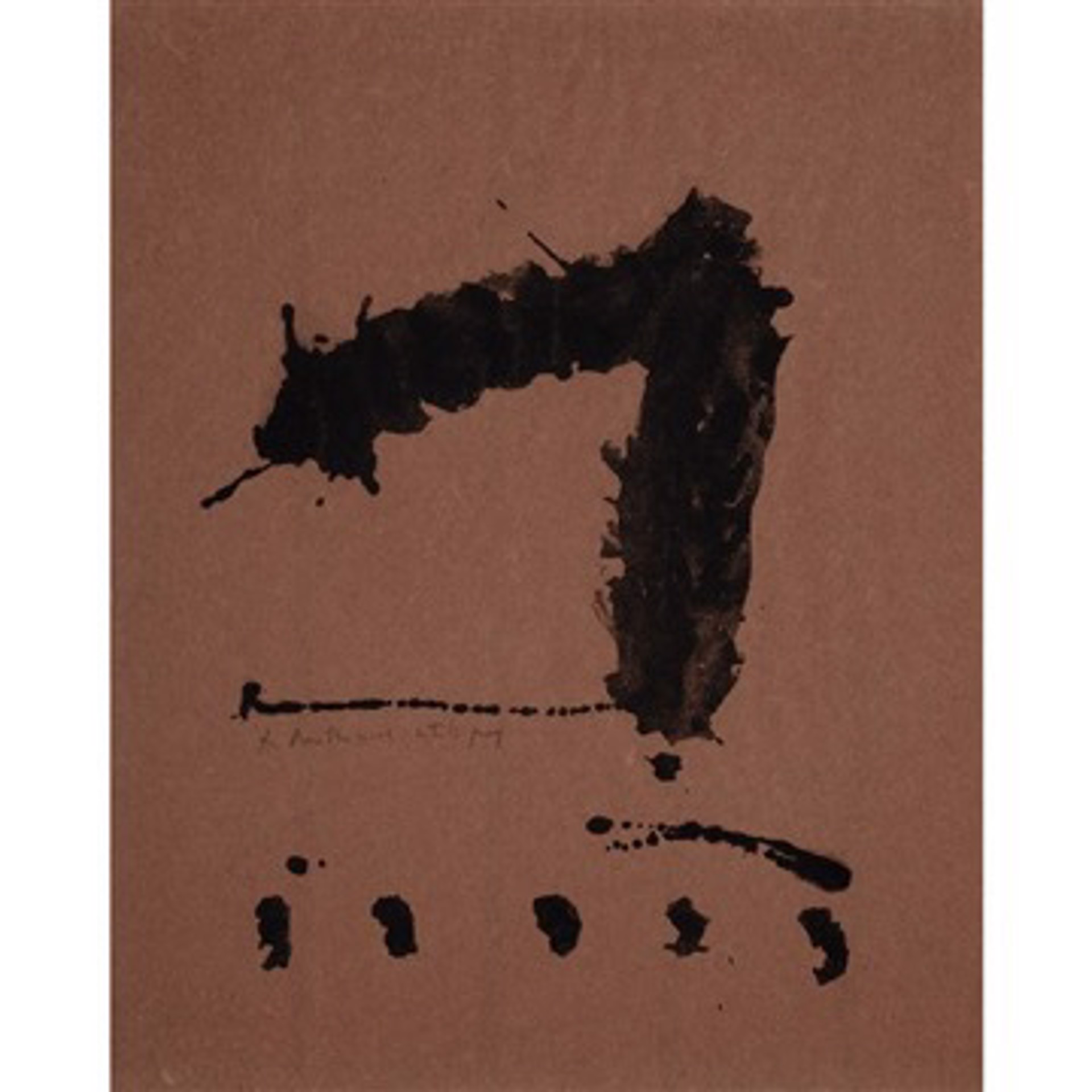Robert Motherwell (American, 1915 - 1991)
Signed "R. Motherwell" and numbered "Artist's Proof", middle in pencil.
This extremely rare print bears very faint mounting tape marks upper left and upper right.
Printed by Irwin Hollander, Hollander Workshop, New York
Published by Spanish Refugee Aid, New York
Catalogue Raisonne Number: Engberg & Banach 57
Framed.
Literature:
Belknap, Dorothy & Terenzio, Stephanie (2009) The Prints of Robert Motherwell. New York, New York: Hudson Hills Press.
Engberg, Siri & Banach, Joan (2003) Robert Motherwell: The Complete Prints 1940-1991: Catalogue Raisonne. New York, New York: Hudson Hills Press.
Museum Collections:
Untitled work can be found in the following selected collections: Emanuel von Baeyer Cabinet, London and the Fogg Museum, Harvard, Massachusetts. Robert Motherwell’s works are in collections across the world, from the Guggenheim Museum, New York; the Smithsonian American Art Museum, Washington, D.C.; the Walker Art Center, Minnesota; the Philadelphia Museum of Art, Pennsylvania; the Harvard Art Museums, Massachusetts; the Whitney Museum of American Art, New York; the Guggenheim Bilbao, Spain; the National Galleries of Scotland, Edinburgh; Tate Gallery, London; Kunstmuseum Basel, Switzerland; the Museu d’Art Contemporani de Barcelona, and many more.
Examples of this work have been exhibited:
London, England, Emanuel Von Baeyer Cabinet, Robert Motherwell: Rare Prints and Proof Sequences.
Notes:
Proofs include unrecorded numbers of AP and TP prints.
One color (black) printed in one run from one zinc plate. An unrecorded number of AP and TP prints were executed.
This print was donated as a fund-raiser to benefit the programs of Spanish Refugee Aid, New York. Organized in 1953 by Nancy Macdonald with the help of Pablo Casals, James Farrell, Mary McCarthy, Dwight Macdonald, Arthur Schlesinger Jr. and Norman Thomas, the organization assisted Spanish Republican refugees referred by the International Rescue Committee in New York and the Spanish veterans committee, Liga de Mutilados. In January 1984, Spanish Refugee Aid became a division of the International Rescue Committee, New York.
Spanish Refugee Aid (SRA) was founded in 1953 to assist refugees of the Spanish Civil War who were then residing in France. Nancy Macdonald (1910-1996) was the leading figure in the founding of Spanish Refugee Aid and remained at the organization’s helm until her retirement in 1983. SRA maintained an office in New York City and coordinated aid efforts in France from Paris, Toulouse and Montauban. Between 1953 and 2006 when SRA, by then a program of the International Rescue Committee, was dissolved, over 5,500 refugees received aid from SRA.
Excerpt from the Museum of Modern Art, New York’s The Painter and the Printer: Robert Motherwell’s Graphics Press Release:
“Motherwell, best known for his work in painting and collage, turned to printmaking, in part, to escape the solitude of the studio. His investigation of the medium soon led to a deeper involvement, as he developed an understanding of its complexities.
His respect for the printers, ‘who selflessly and sensitively become the artist’s alter ego, seeing through the artist’s own eyes,’ is limitless. And he delights as much in the materials themselves as in the challenges of ‘collaborative art.’ Printmaking has, for Motherwell, a certain freshness, directness and economy of means not to be found in most other mediums. Finally, Motherwell enjoys printmaking’s dual personality. As he has said, ‘though prints, in being multiples, are potentially the most public of an artist’s expression, in my case I had always regarded them as the most private – not only because prints are generally intimate in scale and technique, but also making them tended to be more sportif than my work in collage and painting.’”
Propelled by his intense interest in the metaphysical and the subconscious, Motherwell created a large body of these sometimes splashy, sometimes rigid, always energetic images. Automatism, the name coined for this kind of instinctive abstract gesture, also relates to Japanese and Chinese calligraphy, which the artist admired and collected. The greatest series of his calligraphic work was called Beside the Sea and began with 1,000 sheets of rice paper which were to be painted using brushed and splashed ink using unconscious gestures without predetermined direction or the possibility of correction. The series ended at 565 with the news of David Smith’s death in 1965. There were also several other series of gestural work created during his career. These prints are obviously calligraphic but also suggest imagery open to interpretation.
Often Motherwell painted or printed his ‘blacker than black’ gestures over solid colors such as sky blue, raw ochres, rich browns, moody grays, and a bright, crimson or blood red. These gestural etchings and lithographs reveal an elegance not found in the brutality of some of his other works. Among the gestural prints are several from the Octavio Paz Suite, a tribute to the Mexican poet who was a close friend of Motherwell for many decades. These are classic Motherwell images – the spare splash of black, imbued with calligraphic expression and printed on a rice paper ground.

